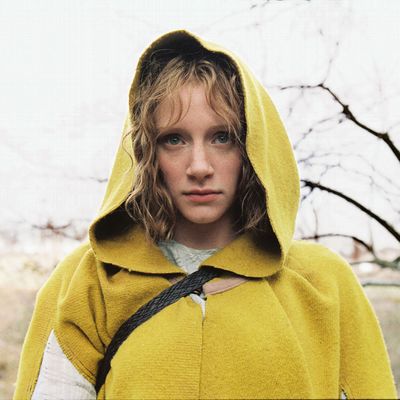
In 2004, against the backdrop of a presidential election focused on cultural conservatism and fear of the Other in the wake of national trauma, two movies used one of the most classic American archetypes ÔÇö the isolated, close-knit village ÔÇö to interrogate the national identity built around it. Only one of the two, Lars von TrierÔÇÖs Dogville, was recognized as such. The other, M. Night ShyamalanÔÇÖs The Village, was widely dismissed as a stilted genre flick that took ShyamalanÔÇÖs famed love of twists to the point of parody. Jeff Reichert at Reverse Shot was one of the few contemporary critics to go against the grain, calling it ÔÇ£a great film that stands apart from just about anything that came out this year.ÔÇØ He was right: The Village is a parable about the 20th century disguised as one about the 18th.
A quick plot summary (here there be spoilers): In what appears to be a colonial frontier town, the elders warn the younger generation against ever leaving the titular village, lest they be menaced by the fearsome red-hued monsters that live in the surrounding woods. But the kids are increasingly curious about the outside world and the monsters themselves, and after a violent incident, one of the youths, a blind girl played by Bryce Dallas Howard, is sent to fetch medicine, revealing in the process that the ÔÇ£monstersÔÇØ are their parents in disguise and that the film in fact takes place in the present day. As the audience learns ÔÇö but Howard does not ÔÇö the elders fled urban crime in the 1970s to create what they imagined was a perfect oasis in the past, and have been using the ÔÇ£monstersÔÇØ as a form of social control.
With its mechanics laid bare, The Village can best be characterized as a story about the trajectory of modern American conservatism, smuggled into what looks like a monster movie. The twists make it clear that the movie isnÔÇÖt really concerned with the things that go bump in the night. Its true subject is white flight, where millions of white Americans abandoned cities due to crime and desegregation (with protestations about the former often used to cover up discomfort with the latter). The village elders are driven by a nostalgia common on the modern American right, rooted in white-identity backlash politics: America used to be a simpler place, a better place, and we can fix all our social ills if we just go back to the way things used to be. In The Village, as in reality, what looks like laissez-faire governance actually requires the partnership of the state with vast amounts of wealth ÔÇö the filmÔÇÖs coda reveals that the village is financially supported by a private fund with the means to pay off the government to prevent every aspect of modern society (even jets) from intruding on their idyllic fantasy.
And, as in American history, the borders of the villageÔÇÖs society are enforced, quite literally, with red-baiting: The elders brainwash their children into rejecting the ÔÇ£bad colorÔÇØ associated with the monsters, to the extent that two teenagers are seen early on fearfully burying a red flower, symbolic of all the growth and change the older generation is working to suppress. (The flower is also an image of sexual awakening, befitting not only the filmÔÇÖs romance subplot but also the sex and gender politics of the era the elders are trying to escape). This color-coded social control brings to mind the Red Scare as much as DHS terror warnings. By trying to recreate what they imagined was the best in America, the elders have reenacted the worst; in the era to which theyÔÇÖre trying so desperately to return, those in the woods deemed ÔÇ£redÔÇØ and cast as savage monsters were the Native Americans, whose lands were being stolen and bodies destroyed. The Village is decidedly anti-utopian ÔÇö a stark rejection of nearly the entirety of the American project, from John WinthropÔÇÖs evocation of the ÔÇ£city on a hillÔÇØ to HollywoodÔÇÖs patronizing, one-dimensional presentations of small-town life. The movie asks why we keep that archetype around, and what nefarious social ends it can be put to even by well-meaning people ÔÇö whether they be politicians, studio executives, or parents.
Indeed, the eldersÔÇÖ experiment ultimately results in the violent incident that unravels their entire scheme. As one of the elders tells Joaquin PhoenixÔÇÖs character: ÔÇ£You can run from sorrow as we have, but sorrow will find you.ÔÇØ Losing yourself in a projection of the past is no true refuge from the issues that plague the present ÔÇö just as the suburban and exurban areas to which so many white Americans fled are not paradise, and the cities are not, as the villagers are warned, ÔÇ£wicked places where wicked people live.ÔÇØ
In this way, The Village belongs to an artistic canon that examines the social movements of late 20th-century America through the prism of fantasy. And why not? Many the animating political ideas in question are fantasy, or require fantasy to keep them alive. The call is coming from inside the house; the true monsters are Mom and Dad, with The Village (like its close cousin A.I. Artificial Intelligence) serving as a scathing examination of the lies parents tell their children. That the movie is set in the present day is meant to shatter our remove, our sense of the past as being behind glass in a museum display. This is still happening, The Village says; just as the elders shouldnÔÇÖt have pretended that the past was free of the problems of the present, so should we in the present not pretend that the past is dead. (As Faulkner reminds us, ÔÇ£itÔÇÖs not even past.ÔÇØ) WeÔÇÖve yet to stop trying to use the myth of the ÔÇ£bad colorÔÇØ monster to make America great again, though The Village offers the hope that the kids will know ÔÇö and vote ÔÇö better.

